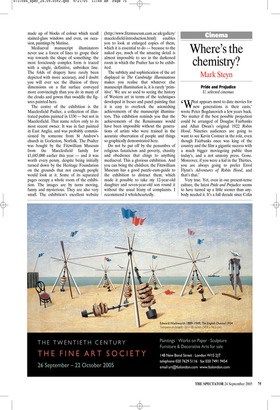Small is beautiful
Alasdair Palmer
The Cambridge Illuminations Fitzwilliam Museum, Cambridge, until 11 December
The Cambridge Illuminations, the Fitzwilliam Museum’s exhibition of mediaeval manuscripts, wasn’t very crowded when I visited last Sunday. The show comprises principally images of devotion, damnation and prayer, conceived and produced by men devoted to poverty, chastity and obedience.
That background seems to put a lot of people off. Poverty, chastity and obedience ... how much more remote from presentday values can you get? And yet, on closer inspection, The Cambridge Illuminations turns out to be a kind of miracle — a breathtaking collection of stupendous paintings that will delight anyone who loves beautiful things. The art here is not only gorgeous, and executed with an exquisite delicacy rarely equalled anywhere; it is also much less alien than might be expected. Pages intended to intensify religious contemplation have, in their margins, depictions of a man fighting a colossal snail; an ape-doctor solemnly diagnosing a bemused bear-patient; and a lady deciding whether to choose as her lover an elegantly attired knight on horseback or a wild, elemental ‘nature man’ from the forest.
Mediaeval piety was concerned with sin, death and damnation — but laughter never seems to have been far from its surface. The twisting tangles of bodies, monsters and dragons which decorate many of the pages on show here are often given comical touches: a tentacular plant sprouts from Abel’s mouth, for instance, slithering across the page before coming back to Abel and terminating in a duck; demons are imprisoned by the curlicues which emerge from their claws or wings; men are depicted literally talking through their own arses. Even the mystical union of Christ and the Church can be given an unexpected edge: in one illustration symbolising that union, a bride and groom are shown embracing. The bride’s hand grips the groom’s wrist, apparently to prevent his hand from groping too far....
There are surprises throughout the show. St Luke is depicted in one 11th-century English illumination with his quill raffishly stuck behind his ear; St Matthew, in an image from the same period, has his pen poised — but is too dazed by the angel who has arrived to inspire him, to be able to write anything; and in a 9th-century Irish Bible, a stylised David exalts symmetrically over a geometrical Goliath. The Bible brought to England from Italy by St Augustine of Canterbury in 597 is here; one wonders what the fur-clad pagan barbarians who then lived in Kent must have thought of its subtle and delicate images of Christ’s agony in the garden, crucifixion and resurrection.
The colours in the illuminations in the 12th-century Bury Bible are fabulous, with a richness and brightness that, given that you are looking at something nearly 900 years old, are almost incredible. The artist, one Master Hugo — he is the first English artist whose name and works have been preserved — demonstrates a ruthless determination to strip out every non-essential detail. The result is a series of startling compositions made up of blocks of colour which recall stained-glass windows and even, on occasion, paintings by Matisse.
Mediaeval manuscript illuminators never use a forest of lines to grope their way towards the shape of something: the most ferociously complex form is traced with a single, definitive, unbroken line. The folds of drapery have rarely been depicted with more accuracy, and I doubt you will ever see the illusion of three dimensions on a flat surface conveyed more convincingly than you do in many of the cloaks and gowns that swaddle the figures painted here.
The centre of the exhibition is the Macclesfield Psalter, a collection of illustrated psalms painted in 1330 — but not in Macclesfield. That name refers only to its most recent owner. It was in fact painted in East Anglia, and was probably commissioned by someone from St Andrew’s church in Gorleston, Norfolk. The Psalter was bought by the Fitzwilliam Museum from the Macclesfield family for £1,685,000 earlier this year — and it was worth every penny, despite being initially turned down by the Heritage Foundation on the grounds that not enough people would look at it. Some of its separated pages occupy a whole room of the exhibition. The images are by turns moving, funny and mysterious. They are also very small. The exhibition’s excellent website (http://www.fitzmuseum.cam.ac.uk/gallery/ macclesfield/introduction.html) enables you to look at enlarged copies of them, which it is essential to do — because to the naked eye, much of the amazing detail is almost impossible to see in the darkened room in which the Psalter has to be exhibited.
The subtlety and sophistication of the art displayed in The Cambridge Illuminations makes you realise that whatever else manuscript illumination is, it is rarely ‘primitive’. We are so used to seeing the history of Western art in terms of the techniques developed in fresco and panel painting that it is easy to overlook the astonishing achievements of the manuscript illuminators. This exhibition reminds you that the achievements of the Renaissance would have been impossible without the generations of artists who were trained in the accurate observation of people and things so graphically demonstrated here.
Do not be put off by the penumbra of religious fanaticism and poverty, chastity and obedience that clings to anything mediaeval. This a glorious exhibition. And you can bring the children; the Fitzwilliam Museum has a good puzzle-cum-guide to the exhibition to distract them, which made it possible to take my 12-year-old daughter and seven-year-old son round it without the usual litany of complaints. I recommend it wholeheartedly.

































































 Previous page
Previous page